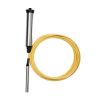Global Water FL16 Flow Logger
Features
- Compact, self-powered and easy to use
- User programmable start and stop alarms, engineering units, and field calibration setup
- Automatic barometric pressure and temperature compensation
- Free ground shipping
- Expedited repair and warranty service
- Lifetime technical support
- More
Overview
The Global Water FL16 Water Flow Loggers will record over 81,000 depth, temperature, water flow and velocity readings in sewer and drainage pipes, as well as other open channel applications like flumes, weirs and square channels. The specially engineered, non-fouling water level sensor works in depths as little as 0.5 inch and allows for deployment in manholes and other difficult to access areas without the need to enter the confined space.
Design
The FL16 Water Flow Recorder's vented water flow sensor is fully encapsulated with marine-grade epoxy. The water flow sensor's electronics are encapsulated so that moisture can never leak in through O-ring seals or work its way into the vent tube and cause drift or sensor failure, as is the case with many other vented water flow sensors. The vent tube is sealed directly to the wet-wet sensing element, and any moisture that may enter the vent tube from the Water Flow Recorder's housing will only contact the ceramic parts, not the electronics.
In The News
Climate Change and Microplastics: Monitoring Lake Champlain
Most people go to Lake Champlain for its exceptional views and thrilling boating, but it’s also home to a wide variety of interesting aquatic research projects. From studying microplastics to thermal dynamics of the lake, Timothy Mihuc, director of the Lake Champlain Research Institute (LCRI) at the State University of New York at Plattsburgh (SUNY Plattsburgh), has spent his career studying aquatic ecosystems. As an aquatic biologist, he’s the main investigator on Lake Champlain’s research studies while also managing their grants, employees, and their hands-on buoy work. Over the years, LCRI has received a number of environmental grants that aid in its monitoring research.
Read MoreCurrent Monitoring after the Francis Scott Key Bridge Collapse
On March 26th, according to The Baltimore Sun , a 984-foot, 112,000-ton Dali lost propulsion and collided with a support column of the Francis Scott Key Bridge, collapsing the structure. Soon after the event, search and rescue, salvage crews, and other emergency responders were mobilized after the collision. As salvage efforts progressed in early April, NOAA’s Center for Operational Oceanographic Products and Services (CO-OPS) responded to a request for real-time tidal currents data and deployed a current monitoring buoy—CURBY (Currents Real-time BuoY)—into the Patapsco River north of the Francis Scott Key Bridge.
Read MoreSoundscapes of the Solar Eclipse: Citizen Science Supporting National Research
On April 8, 2024, millions of people around the world had their eyes glued to the sky to witness a historic cosmic event. The total solar eclipse captured the headlines and the minds of many who became eager to gaze at the heavens as the sky went dark for a few minutes. However, not everyone used their sense of sight during the eclipse, some were listening to the sounds of the natural world around them as the light faded from above. The Eclipse Soundscape Project is a NASA-funded citizen science project that focuses on studying how the annular solar eclipse on October 14, 2023, and the April 8, 2024 total solar eclipse impacted life on Earth. The project revisits an initiative from the 1930s that showed animals and insects are affected by solar eclipses.
Read More








